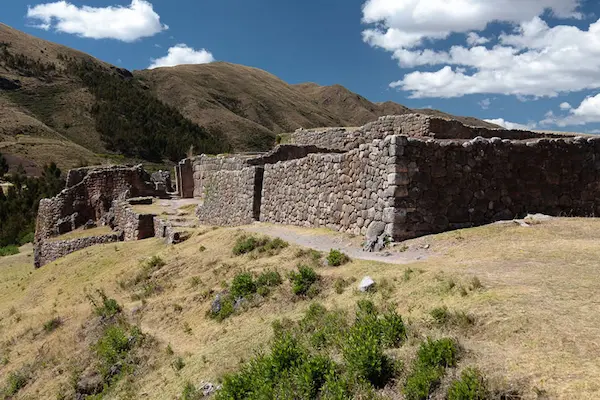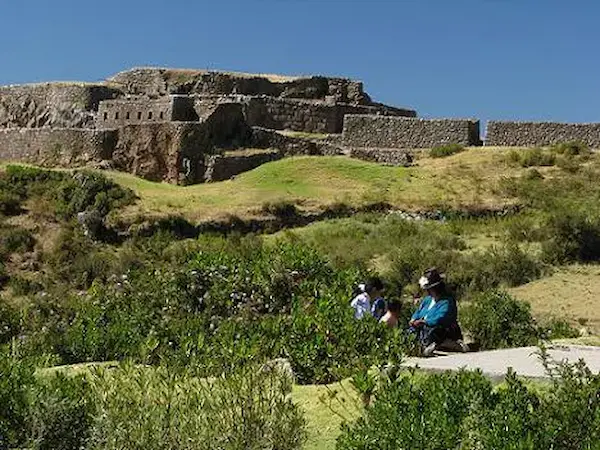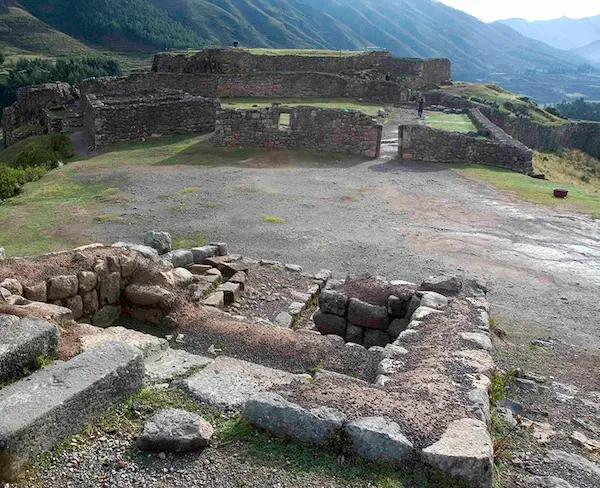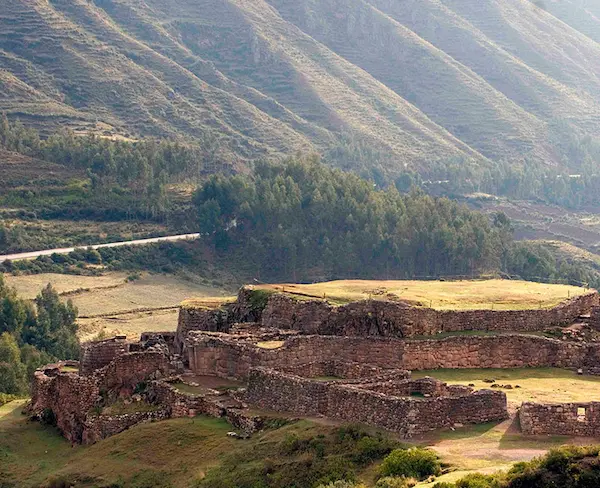Av Retamayoc L-10, San Sebastián 08002
- +51 940 809 144
- Travel Blog
- About Us
- Contact Us
Av Retamayoc L-10, San Sebastián 08002
Chat to a Andean Road Peru
Puka Pukara archaeological complex, also known as the Red Fortress, is an impressive archaeological site from the ancient Inca Empire. Located in the Peruvian Andes, about 7 kilometers from Cusco and at an altitude of 3,850 meters above sea level, its name comes from the distinctive reddish hue of the stones that form its walls. This site played a crucial role in the Inca road network, recognized for its military importance and its connection to other ceremonial sites.
Nestled in the stunning landscapes of the Sacred Valley, the Puka Pukara Archaeological Complex stands as a remarkable testament to the ingenuity and cultural significance of the Inca civilization. Often overlooked in favor of the more famous ruins of Machu Picchu or Sacsayhuamán, Puka Pukara offers visitors a chance to explore a fascinating site that highlights the Inca's mastery of engineering, architecture, and military strategy.
Puka Pukara is located approximately 8 kilometers from the city of Cusco, the former capital of the Inca Empire. It sits on a strategic hilltop, overlooking the surrounding valley, offering both impressive views and a key defensive position. The archaeological complex is easy to reach from Cusco, either by taxi, public bus, or as part of a guided tour that typically includes a visit to other nearby sites like Tambomachay and Qenqo. The site is also accessible on foot for those seeking a more immersive experience, with surrounding trails offering panoramic views of the Inca landscape.
Maybe you’d like to read: Chinchero: A glimpse into the living inca culture

The name "Puka Pukara" translates to "Red Fortress" in Quechua, referring to the reddish color of the stone used in the construction of the site. It is believed to have been built by the Incas during the reign of Pachacuti, the ninth Sapa Inca, who expanded the empire's boundaries and strengthened its military and political control. However, the exact purpose of the site remains a subject of debate among archaeologists and historians.
Some theories suggest that Puka Pukara functioned primarily as a military outpost or fortress, guarding the important Inca road that passed through the area. Others believe it may have been a ceremonial or administrative center, or even a rest stop for travelers moving between Cusco and the far-reaching corners of the empire. Whatever its intended function, Puka Pukara Archaeological Complex played an important role in the Inca's vast network of roads, temples, and fortresses that spanned across the Andes.
One of the most striking aspects of Puka Pukara Archaeological Complex is its impressive stonework. Like many other Inca sites, the builders used precisely cut stones that fit together without mortar, a technique that has allowed the structures to withstand centuries of earthquakes and harsh weather conditions. The walls, terraces, and staircases of Puka Pukara showcase the Inca’s advanced understanding of engineering and construction.
The site is divided into several distinct areas, each with its own function and design. There are several terraces, which were likely used for agricultural purposes or to provide additional space for the settlement. The complex also includes a series of plazas, which may have served as gathering places for the Inca military or local community. The highlight of the site is the fortress-like structure itself, with its commanding position overlooking the surrounding valley and providing an excellent vantage point for any potential military threat.
Puka Pukara features rectangular buildings, with some used for storage or as living quarters. The careful placement of windows and doorways suggests that the Incas had a deep understanding of natural light and ventilation, further showcasing their advanced knowledge of architecture. The site’s strategic location, combined with the careful layout of the buildings, made it an ideal place for the Inca to control access to the region and protect their capital city of Cusco.
Maybe you’d like to read: Visiting Pisac ruins: A Journey through history and culture

Puka Pukara’s location was undoubtedly one of its most significant features. Situated on a high hilltop, the complex provided an unobstructed view of the surrounding valley and any approaching invaders. It controlled the entryway into the Cusco Valley, an area that was critical to the Inca Empire’s political, economic, and cultural dominance. The site would have allowed the Incas to monitor movement along the extensive Inca road system, which was essential for communication and the transportation of goods, soldiers, and tribute across the empire.
The Inca military used this strategic position to control access to the region, ensuring that only authorized people could pass through. The site included small watchtowers and other defensive structures manned by soldiers, ready to defend against any potential threat.The military importance of Puka Pukara Archaeological Complex is further emphasized by the nearby Tambomachay, which is thought to have served as a ritual or administrative center, highlighting the strategic significance of the area as a whole.
While Puka Pukara was undoubtedly a military outpost, it also had symbolic importance. As with many Inca sites, the location and design of the complex may have served to communicate power, control, and the divine nature of the Inca rulers. The Incas were masters of symbolism, and the positioning of Puka Pukara Archaeological Complex in the landscape, as well as the careful design of its structures, may have been a reflection of the empire's dominance and authority.
For visitors, Puka Pukara Archaeological Complex offers an opportunity to explore an Inca site that is less crowded and more tranquil than the more famous ruins of the Sacred Valley. Walking through the complex, visitors can imagine what life might have been like for the Inca soldiers or administrators who once inhabited the area.
Puka Pukara is also a great destination for hiking enthusiasts. The surrounding hills and trails offer plenty of opportunities to explore the natural beauty of the region, with several scenic routes that connect the archaeological complex to other sites like Tambomachay, Qenqo, and even the city of Cusco itself. For those looking to learn more about Inca culture, a visit to Puka Pukara Archaeological Complex provides insight into the advanced engineering and strategic thinking that helped the Inca Empire become one of the largest and most powerful civilizations in the Americas.
Maybe you’d like to read: The History of Tambomachay: The Inca Water Temple

While Puka Pukara Archaeological Complex may be a lesser-known archaeological site, it is part of a larger group of fascinating Inca sites in the Cusco region. Tambomachay, located just a short distance away, is another important site that may have served as a ceremonial center or a place for water rituals. Known as the "Baths of the Inca," Tambomachay features impressive stonework and fountains that still flow with fresh mountain water.
The nearby site of Qenqo, another key part of the Inca road system, offers visitors a chance to explore intricate stone carvings and tunnels that may have been used for ritual purposes. Together with Puka Pukara Archaeological Complex, these sites form a unique and less-explored route for those interested in the history and culture of the Inca Empire.
Puka Pukara Archaeological Complex’s significance is enhanced when considering its role in the larger Inca road network. The Incas built an extensive system of roads that spanned the length of their empire, from modern-day Colombia in the north to Chile in the south. These roads facilitated the movement of soldiers, merchants, and tribute, and helped unify the vast and diverse empire.
Puka Pukara Archaeological Complex was a key stop along one of these roads, serving as both a military outpost and a resting place for travelers. The road system was vital to the cohesion of the empire and allowed the Incas to maintain control over their territories. Visiting Puka Pukara Archaeological Complex allows travelers to understand the significance of the road system and its role in the success of the Inca Empire.
Maybe you’d like to read: Exploring the Sacred Koricancha: The temple of the sun

Puka Pukara Archaeological Complex may not have the same level of fame as other Inca sites, but its historical and cultural significance is undeniable. From its strategic location and military function to its architectural marvels and cultural symbolism, the site offers visitors a glimpse into the genius of the Inca civilization. Exploring Puka Pukara Archaeological Complex allows travelers to step back in time and imagine life in the heart of the Inca Empire, while also offering a peaceful and scenic experience away from the crowds.
Whether you are a history enthusiast, a lover of archaeology, or simply someone looking to experience the beauty and culture of the Andes, a visit to Puka Pukara Archaeological Complex is sure to be a memorable and enriching experience. Its rich history, stunning views, and fascinating architecture make it a must-visit destination in the Cusco region.
Leave a comment